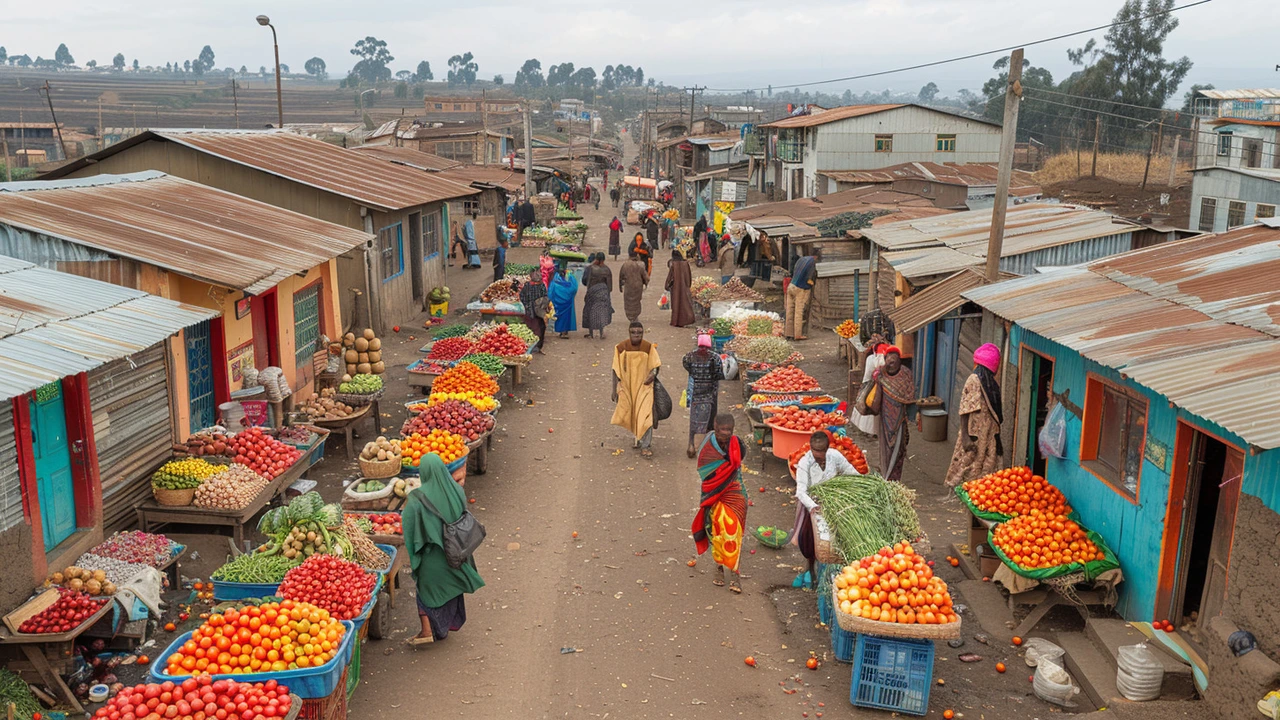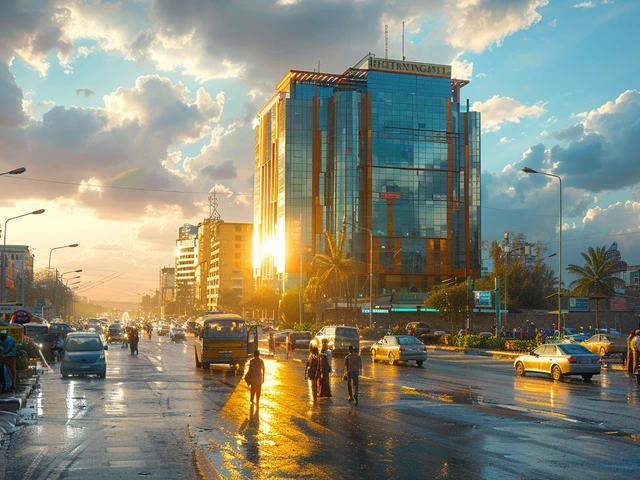Ethiopia, known for its deep-rooted history and rich cultural tapestry, also presents a unique economic landscape ripe for exploration. Understanding the average income of its citizens, especially when measured in US dollars, can offer valuable insights into the country's financial health and development.
The average income in Ethiopia stands as a reflection of a myriad of factors, from its agricultural backbone to the burgeoning urban centers. By examining detailed data, looking at urban vs rural disparities, and considering the global context, one can grasp how Ethiopians fare financially and what drives their economic journey.
- Ethiopia's Economic Landscape
- Average Income Data
- Urban vs Rural Income
- Factors Influencing Income Levels
- Global Comparisons
Ethiopia's Economic Landscape
Ethiopia's economic landscape is both diverse and dynamic, reflecting its vast history and rapid development. As of 2024, Ethiopia remains one of Africa’s fastest-growing economies, boasting an average annual growth rate of around 7% over the past decade. This impressive growth, however, contrasts sharply with the significant challenges the country faces, such as poverty, unemployment, and a high rural population dependent on subsistence agriculture.
A fundamental aspect of Ethiopia's economy is its reliance on agriculture, which employs approximately 70% of the workforce and contributes about a third of the country's GDP. Coffee stands out as one of Ethiopia's most critical exports, and the nation is renowned as the birthplace of this beloved beverage. Agriculture's dominance in the economy means that climatic changes and global commodity prices critically affect Ethiopian livelihoods.
Over the years, Ethiopia has been making strides to diversify its economy. The government has invested heavily in infrastructure projects, including roads, railways, and hydroelectric power projects. The Grand Ethiopian Renaissance Dam (GERD), once completed, is expected to become Africa's largest hydroelectric power plant, significantly boosting the country's energy capacity and economic output. The government's focus on developing the manufacturing sector, especially textiles and garments, aims to generate jobs and reduce poverty.
Urbanization has rapidly increased in recent years, with cities like Addis Ababa experiencing vast developments. These urban centers are becoming hubs of economic activity, offering more employment opportunities in services and industrial sectors. This shift has led to a growing middle class, although the benefits of urbanization are not evenly distributed.
Despite economic growth, Ethiopia faces numerous hurdles. Political instability, internal conflicts, and regional disputes pose significant risks to ongoing development. Inflation has been a lingering issue, eroding purchasing power and affecting the average income. Additionally, while international aid and remittances play crucial roles in the economy, dependency on these sources can be unpredictable.
Interestingly, Ethiopia’s young population is both a challenge and an opportunity. Over 60% of Ethiopians are under the age of 25. This demographic could potentially drive economic growth if adequately harnessed through education and job creation. On the other hand, failing to provide sufficient opportunities could exacerbate unemployment and social unrest.
As Ethiopia moves forward, balancing tradition with modernity remains key to its economic strategy. The blend of agricultural heritage with industrial ambition paints a complex picture of a country at the crossroads of change. According to the World Bank, maintaining macroeconomic stability while fostering inclusive growth is crucial for Ethiopia’s sustained development.
“Ethiopia’s economic resilience over the past years is commendable, but it is essential to address vulnerabilities and ensure that growth benefits all segments of society.” - World Bank Report 2023
Average Income Data
When exploring the average income in Ethiopia, one must consider a range of factors that reflect the economic diversity and complexity of the nation. According to recent statistics, the average monthly income for an Ethiopian worker is estimated to be around 2,000 Ethiopian Birr, which equates to approximately 40 to 50 US dollars. This figure provides a glimpse into the modest earnings of many Ethiopians, particularly those in rural areas where agriculture remains the dominant livelihood.
It's important to note that these income figures can vary significantly between urban and rural areas. In cities like Addis Ababa, the capital, wages tend to be higher due to better access to jobs in sectors such as business, technology, and services. Urban dwellers often earn two to three times more than their rural counterparts, partly because of more significant employment opportunities and higher costs of living. In contrast, many rural Ethiopians rely heavily on subsistence farming, which can limit their cash income.
Disparities in income levels also arise from differences in industry and educational background. For example, individuals working in the technology or financial services sectors may enjoy higher salaries, while those in agriculture or informal labor markets see much lower earnings. Educational attainment plays a pivotal role, too; Ethiopians with higher education degrees generally have access to better-paying jobs.
In a 2023 report by the World Bank, it was highlighted that despite Ethiopia's impressive economic growth in the past decade, income distribution remains uneven.
“While Ethiopia has made significant strides in reducing poverty and spurring economic growth, persistent income inequality poses challenges to sustainable development,” the report stated.Such findings emphasize the need for economic reforms and policies aimed at equitable distribution of wealth to bridge the income gap.
Average income data is also influenced by gender. Ethiopian women, on average, earn less than men, often due to limited access to education and employment opportunities. Tackling gender disparities in income is crucial for achieving a balanced economic environment.
Additionally, external factors such as inflation and currency fluctuations impact average income figures. The value of the Ethiopian Birr against the US dollar fluctuates, affecting purchasing power and real income. For instance, inflation rates have been climbing, leading to higher costs of goods and services, which further strains the average Ethiopian's budget.
Despite these challenges, efforts are being made to enhance earning potentials. Government initiatives to promote industrialization, improve education, and provide vocational training aim to enable more Ethiopians to secure better-paying jobs. As these strategies take root, there is hope for a gradual increase in the average income level of the population.
To understand the economic context fully, it's helpful to look at income data over time. Trends suggest steady progress, although at a gradual pace. Future projections by economic analysts indicate that if current growth trends continue, average incomes in Ethiopia can see substantial improvement in the next decade.

Urban vs Rural Income
In Ethiopia, the economic divide between urban and rural areas is quite pronounced, revealing significant differences in income levels across the country. The bustling urban centers like Addis Ababa and Dire Dawa are often home to higher-income opportunities compared to the largely agrarian rural regions. This gap is primarily driven by the availability of jobs, access to education, and the resulting skill sets of the populace.
Urban residents typically benefit from better employment opportunities, especially in sectors such as service, trade, and manufacturing. The average income for those living in cities is significantly higher than for their rural counterparts. For example, residents in Addis Ababa often earn more due to the presence of multinational companies, government institutions, and better infrastructure which supports various economic activities. Additionally, urban areas attract skilled professionals from different parts of the country, which increases competition and, subsequently, wages.
On the other hand, rural Ethiopia largely depends on agriculture, a sector that is sometimes volatile due to factors like drought and soil degradation. Although agriculture remains the backbone of the Ethiopian economy, contributing around 34% to the nation's GDP, the incomes derived from farming are much lower and less stable compared to those from urban employment. Limited access to markets, lower levels of mechanization, and traditional farming methods often restrict productivity and income in these regions.
The disparity is also evident in educational attainment. Urban areas have better educational facilities, which translates to higher literacy rates and more people with higher education degrees. This educational advantage allows urban residents to secure higher-paying jobs, perpetuating the income gap. In rural areas, children often have to travel long distances to attend school, if they are able to attend at all, and many families prioritize immediate agricultural work over long-term education.
The Ethiopian government has recognized these disparities and is working on various programs aimed at rural development. Initiatives such as improving rural infrastructure, promoting sustainable agricultural practices, and enhancing access to education and healthcare are steps in the right direction. However, these changes require time and sustained effort to effectively bridge the income gap between urban and rural communities.
In the larger context of global comparisons, the urban-rural income gap in Ethiopia mirrors the trends seen in many developing nations. Rapid urbanization often brings about both opportunities and challenges, including the need to manage resource distribution fairly across the populace. As Ethiopia continues to develop, balancing growth between urban and rural areas will be vital for ensuring equitable economic progress.
"Ethiopia's potential for growth is immense, but equally vital is ensuring that growth is inclusive and benefits all citizens, regardless of their location" – World Bank Report on Ethiopia's Economic Outlook.
To sum up, while urban areas in Ethiopia present higher income opportunities, rural regions lag behind due to various structural challenges. Addressing these issues comprehensively could pave the way for more balanced and sustainable economic development across the nation.
Factors Influencing Income Levels
Delving into the average income in Ethiopia, several pivotal factors come to light that shape the earnings of its citizens. One primary factor is the country's dependency on agriculture. Agriculture forms the backbone of Ethiopia's economy, employing a significant portion of the population. However, agricultural productivity and subsequently incomes are often affected by variables such as unpredictable weather patterns and limited access to modern farming techniques.
Education is another critical aspect. There is a noticeable correlation between educational attainment and income levels. Individuals who complete higher education typically earn more, partly because they can access better job opportunities in growing sectors like technology and services. However, education systems in rural areas lag behind, creating a gap in income potential.
Urbanization also plays a substantial role. Urban areas like Addis Ababa offer more job opportunities, higher wages, and better living standards compared to rural regions. This urban-rural divide significantly impacts income disparities. Migration to cities in search of better prospects is common, although it comes with its own challenges, such as increased living costs and competition for jobs.
Moreover, the influence of economic policies cannot be overlooked. Government initiatives aimed at infrastructure development, industrialization, and foreign investments have a profound effect on income levels. For instance, Ethiopia's Growth and Transformation Plan (GTP) aims to sustain rapid and equitable economic growth, which can trickle down to increased incomes for ordinary Ethiopians.
Global economic dynamics also have a say. Being connected to the global market means that international trade agreements, foreign aid, and global economic trends impact Ethiopia's economy and, by extension, individual incomes. Fluctuations in the global prices of key exports like coffee can either bolster or diminish the earnings of local farmers.
"Our aim is to create a resilient economy that is less vulnerable to external shocks while ensuring that income generation is equitable," says Abebe Aemro Selassie, Director of the IMF's African Department.
Additionally, gender disparities contribute to income variances. Despite progress, women in Ethiopia often earn less than men due to traditional roles, limited access to education, and other socio-economic barriers. Policies supporting women's education and participation in the workforce are crucial for bridging this gap.
Health infrastructure also impacts income levels. Better health care means a healthier workforce, which translates to higher productivity and income. Inadequate health services in rural areas can often lead to lost working days and reduced earnings.
Lastly, technological advances are enabling new earning opportunities. With the rise of Internet access and mobile technology, even people in remote areas can avail themselves of new job opportunities or enhance their existing businesses. This shift is gradually transforming income landscapes across the country.

Global Comparisons
When assessing the average income in Ethiopia in a global context, it becomes clear that the nation faces significant economic challenges. As of 2024, the World Bank notes that the Gross National Income (GNI) per capita in Ethiopia is around 890 US dollars. This figure positions Ethiopia at the lower end of international income scales, particularly when compared to developed nations like the United States, where the GNI per capita is upwards of 65,000 US dollars.
It's essential to understand that average income is a broad indicator influenced by numerous factors. For instance, neighboring Kenya has a GNI per capita of approximately 1,780 US dollars, almost double that of Ethiopia. Various factors contribute to these discrepancies, such as differences in industrialization, educational attainment, and access to health care. Such disparities highlight the diverse economic landscapes within even a small geographic region.
To put these figures into more perspective, consider the income levels of European countries. Germany, one of the strongest economies in Europe, boasts a GNI per capita of around 48,000 US dollars. These stark contrasts underscore the vast economic divide that separates Ethiopia from more prosperous nations. The disparity is even more pronounced when looking at small, high-income countries like Luxembourg, where the GNI per capita exceeds 100,000 US dollars.
Despite these differences, Ethiopia has made notable strides in recent years. According to the International Monetary Fund (IMF), the country's economy has grown at an average rate of around 9% per year over the past decade. This rapid economic growth has somewhat improved the average income, though it remains insufficient to significantly bridge the gap with higher-income nations.
One of the challenges Ethiopia faces in increasing its average income is its reliance on agriculture, which employs about 70% of the population but contributes less than 40% to the GDP. Developing industries and services sectors are crucial steps to diversifying the economy and improving income levels. Nations like China and India have successfully moved large portions of their populations from low-income agricultural work to higher-income industrial and service jobs, which is an essential model for Ethiopia to consider.
Another encouraging sign is the increase in foreign investments. The Ethiopian government has active programs targeting infrastructure enhancements and sectoral diversification, facilitating pathways for economic growth. For example, the Hawassa Industrial Park, which primarily focuses on textile manufacturing, has attracted significant foreign direct investment, providing thousands of jobs and boosting the local economy.
In summary, hearing Ethiopia's income data in isolation might paint a grim picture, but when considering global comparisons, it's also essential to recognize the progress and potential. The country's challenges are significant, but so are the opportunities for growth. With strategic investments and a focus on economic diversification, there's a realistic path for enhancing the average income and bettering the lives of millions of Ethiopians.

 Navigating Employment Opportunities for Foreigners in Ethiopia
Navigating Employment Opportunities for Foreigners in Ethiopia
 Current Employment Statistics in Ethiopia for 2024
Current Employment Statistics in Ethiopia for 2024
 Profitable Banks in Ethiopia: A Deep Dive into Financial Success
Profitable Banks in Ethiopia: A Deep Dive into Financial Success
 Understanding the Major Health Concerns in Ethiopia
Understanding the Major Health Concerns in Ethiopia
 Exploring Common Occupations in Ethiopia for 2024
Exploring Common Occupations in Ethiopia for 2024
Jordan Fields
June 20, 2024 AT 17:35The data indicates that Ethiopia’s average monthly earnings hover around $40‑$50 USD, reflecting the country’s agrarian basis and uneven urban‑rural distribution.
Divyaa Patel
June 21, 2024 AT 19:37Imagine the golden sunrise over the highlands, where each farmer’s toil is measured not just in beans but in the whisper of dollars that barely cover a modest meal.
In this fragile dance between tradition and ambition, the average income becomes a mirror for a nation straddling antiquity and modernity.
The urban corridors of Addis Ababa pulse with opportunity, while the rural plains echo the age‑old rhythm of subsistence.
Such disparity is not merely statistical; it is a living, breathing paradox that shapes hopes, fears, and the very soul of Ethiopia.
One cannot discuss numbers without feeling the undercurrent of resilience that propels every Ethiopian forward.
Larry Keaton
June 22, 2024 AT 21:39Yo, fam! Ethiopia’s economy is kinda like a rollercoaster-big growth numbers but the cash flow for most folks is still super low.
We’re talkin’ $40‑$50 a month on average, which means a lot of people are still hustlin’ just to put food on the table.
Urban spots like Addis are pullin’ in more cash, but the countryside? Yeah, they’re still stuck in that subsistence grind.
Gotta give props to the government’s road projects, though-those new highways might finally link farmers to markets and boost those tiny incomes.
Still, there’s a long road ahead before most Ethiopians can feel the real buzz of prosperity.
Liliana Carranza
June 23, 2024 AT 23:41Hey there! Let’s celebrate the hustle that’s out there-Ethiopians are grinding every day, turning tiny earnings into big dreams.
Even if the average paycheck seems modest, the spirit in both city streets and village fields is unstoppable.
Every extra birr saved is a step toward education, health, and brighter futures.
Keep pushing, stay hopeful, and remember that collective effort will lift the whole community.
Jeff Byrd
June 25, 2024 AT 01:42Sure, because nothing says “economic success” like a $50 paycheck.
Joel Watson
June 26, 2024 AT 03:44One must approach Ethiopia’s fiscal portrait with a discerning eye, eschewing the myopic lens of raw dollars to apprehend the nuanced interplay of structural variables.
The per capita figure, albeit modest, is a symptom of a historical legacy wherein agrarian dependence eclipses industrial diversification.
When scrutinized through the prism of developmental economics, the disparity between urban and rural income streams reveals a systemic inertia that resists facile quantification.
Moreover, the volatility of commodity prices, particularly coffee, imposes exogenous shocks that reverberate across the macro‑economic fabric.
Thus, any superficial analysis that merely tallies the nominal average without contextualizing institutional frameworks is destined to falter.
Chirag P
June 27, 2024 AT 05:46I appreciate the depth of your analysis and agree that structural factors are pivotal; however, I’d add that recent infrastructure investments may gradually mitigate some of those entrenched disparities.
RUBEN INGA NUÑEZ
June 28, 2024 AT 07:48The numbers you’re seeing-roughly $40‑$50 per month-are indeed low, but they also reflect a baseline that can be built upon through targeted education and vocational training programs.
When we equip individuals with marketable skills, the income trajectory can shift upward, especially in emerging sectors like renewable energy and textiles.
Consistent policy support and private sector partnerships are essential to translate these opportunities into real wage growth.
Michelle Warren
June 29, 2024 AT 09:50Honestly this whole thing is overhyped. Everybody keeps talking about “growth” but the average joe still cant afford basic stuff. The stats are just numbers on a page, real life ain’t changed much.
Christopher Boles
June 30, 2024 AT 11:52While the challenges are real, it’s encouraging to see incremental improvements in education access and micro‑enterprise support that can eventually lift average earnings.
Crystal Novotny
July 1, 2024 AT 13:53Numbers alone don’t capture the lived experience; they’re a veneer that masks deeper systemic flaws.
Reagan Traphagen
July 2, 2024 AT 15:55That veneer, as I see it, is meticulously crafted by global financiers who profit from keeping developing economies in perpetual dependency. The aid flows are a subtle leash ensuring Ethiopia remains a pawn in larger geopolitical games.
mark sweeney
July 3, 2024 AT 17:57I’ve been scrolling through the usual headlines about Ethiopia’s “miraculous” growth and I can’t help but roll my eyes.
Sure, the GDP numbers look shiny, but average income is still stuck in the single digits of dollars.
What most articles gloss over is that the bulk of that growth is funneled into massive infrastructure projects that rarely benefit the average farmer.
The Grand Ethiopian Renaissance Dam, for all its hype, will primarily serve big industrial players and export contracts, not the smallholder tapping his own well.
Meanwhile, urban migrants pour into Addis, chasing jobs that are as scarce as rain in the lowlands.
Their wages are often just a few birr above subsistence, barely enough to cover rent and food.
And let’s not forget the inflation monster that eats any extra cash the moment it lands in a pocket.
The government’s push for textile parks sounds great on paper, but the reality is that most workers end up on contract agreements with shoddy conditions.
If you look at the gender gap, women still earn a fraction of what men do, despite education gains.
Even the World Bank’s rosy forecasts ignore the fact that climate change is turning the highlands into a harsher place to farm.
Drought cycles are getting longer, and with a 70% agricultural workforce, that spells trouble for incomes.
I’ve talked to locals who say they’re more worried about the next rainy season than any promise of GDP growth.
The foreign debt climb is another red flag; loan repayments will soon divert resources away from social programs.
All this makes me skeptical of any narrative that paints Ethiopia’s economic future as anything but uncertain.
So until we see real wage hikes that lift daily living standards, those “average income” statistics remain a hollow brag.
randy mcgrath
July 4, 2024 AT 19:59You raise valid points and remind us that macro indicators can be misleading; focusing on tangible wage improvements is indeed the essential metric for assessing progress.